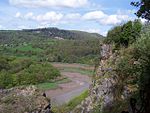Wyndcliffe Court
Arts and Crafts architecture in WalesArts and Crafts gardensCountry houses in MonmouthshireGardens by Henry Avray TippingGrade II* listed buildings in Monmouthshire ... and 4 more
History of MonmouthshireHouses completed in 1922Pages containing London Gazette template with parameter supp set to yRegistered historic parks and gardens in Monmouthshire

Wyndcliffe Court, 0.5 miles (0.80 km) north of the village of St. Arvans, Monmouthshire, Wales, is a Grade II* listed country house and gardens in the Arts and Crafts style, completed in 1922. The client was Charles Leigh Clay and the architect Eric Francis. The gardens were designed by Henry Avray Tipping and are included on the Cadw/ICOMOS Register of Parks and Gardens of Special Historic Interest in Wales.
Excerpt from the Wikipedia article Wyndcliffe Court (License: CC BY-SA 3.0, Authors, Images).Wyndcliffe Court
Penterry Lane,
Geographical coordinates (GPS) Address Nearby Places Show on map
Geographical coordinates (GPS)
| Latitude | Longitude |
|---|---|
| N 51.6719 ° | E -2.6984 ° |
Address
Penterry Lane
Penterry Lane
NP16 6EY , St Arvans
Wales, United Kingdom
Open on Google Maps










